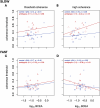Poor fixation stability does not account for motion perception deficits in amblyopia
- PMID: 39863630
- PMCID: PMC11762986
- DOI: 10.1038/s41598-024-83624-9
Poor fixation stability does not account for motion perception deficits in amblyopia
Abstract
People with amblyopia show deficits in global motion perception, especially at slow speeds. These observers are also known to have unstable fixation when viewing stationary fixation targets, relative to healthy controls. It is possible that poor fixation stability during motion viewing interferes with the fidelity of the input to motion-sensitive neurons in visual cortex. To probe these mechanisms at a behavioral level, we assessed motion coherence thresholds in adults with amblyopia while measuring fixation stability. Consistent with prior work, participants with amblyopia had elevated coherence thresholds for the slow speed stimuli, but not the fast speed stimuli, using either the amblyopic or the fellow eye. Fixation stability was elevated in the amblyopic eye relative to controls across all motion stimuli, and not selective for conditions on which perceptual deficits were observed. Fixation stability was not related to visual acuity, nor did it predict coherence thresholds. These results suggest that motion perception deficits might not be a result of poor input to the motion processing system due to unstable fixation, but rather due to processing deficits in motion-sensitive visual areas.
Keywords: Amblyopia; Fixation stability; Global motion perception; Motion coherence; Speed.
© 2025. The Author(s).
Conflict of interest statement
Declarations. Competing interests: The authors declare no competing interests.
Figures






Similar articles
-
Dichoptic Visual Search at Varied Fellow Eye Contrasts and Visual Function Deficits in Amblyopia.Invest Ophthalmol Vis Sci. 2025 Jul 1;66(9):39. doi: 10.1167/iovs.66.9.39. Invest Ophthalmol Vis Sci. 2025. PMID: 40657969 Free PMC article.
-
Determining fixation accuracy with optical coherence tomography and its implication on visual acuity in amblyopia.Vision Res. 2025 Oct;235:108659. doi: 10.1016/j.visres.2025.108659. Epub 2025 Jul 9. Vision Res. 2025. PMID: 40639008
-
Binocular and Fellow Eye Acuity Deficits in Amblyopia: Impact of Fixation Instability and Sensory Factors.J Eye Mov Res. 2025 Jun 3;18(3):20. doi: 10.3390/jemr18030020. eCollection 2025 Jun. J Eye Mov Res. 2025. PMID: 40568225 Free PMC article.
-
Assessing the comparative effects of interventions in COPD: a tutorial on network meta-analysis for clinicians.Respir Res. 2024 Dec 21;25(1):438. doi: 10.1186/s12931-024-03056-x. Respir Res. 2024. PMID: 39709425 Free PMC article. Review.
-
Defining disease severity in atopic dermatitis and psoriasis for the application to biomarker research: an interdisciplinary perspective.Br J Dermatol. 2024 Jun 20;191(1):14-23. doi: 10.1093/bjd/ljae080. Br J Dermatol. 2024. PMID: 38419411 Free PMC article. Review.
References
-
- McKee, S. P., Levi, D. M. & Movshon, J. A. The pattern of visual deficits in amblyopia. J. Vis.3, 380–405. 10.1167/3.5.5 (2003). - PubMed
-
- Baker, D. H., Meese, T. S. & Hess, R. F. Contrast masking in strabismic amblyopia: Attenuation, noise, interocular suppression and binocular summation. Vis. Res.48, 1625–1640. 10.1016/j.visres.2008.04.017 (2008). - PubMed
-
- Hayward, J., Truong, G., Partanen, M. & Giaschi, D. Effects of speed, age, and amblyopia on the perception of motion-defined form. Vis. Res.51, 2216–2223. 10.1016/j.visres.2011.08.023 (2011). - PubMed
MeSH terms
LinkOut - more resources
Full Text Sources
Medical

